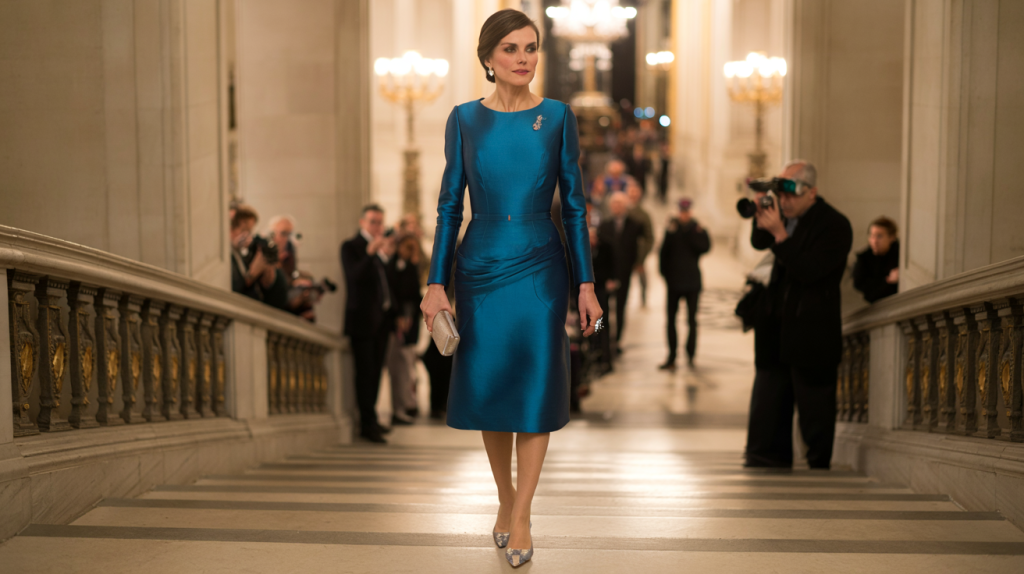Queen Letizia of Spain and the power of a French dress
Spotlight on a silhouette that speaks before a word is said. When Queen Letizia of Spain steps out in a French dress, the look lands with quiet precision: sharp waist, clean line, fabric that holds, and color chosen to photograph beautifully. It is style with intent, instantly legible on a crowded red carpet or a state staircase.
The context helps. Letizia Ortiz became Queen consort on 19 June 2014, and since then her wardrobe has balanced Spanish craftsmanship with strategic nods to European heritage. A French-made piece sends a neat diplomatic message: Parisian savoir-faire, codified since the late 19th century, aligned with a modern, no-fuss Spanish aesthetic. The result rarely goes unnoticed.
French codes that flatter Queen Letizia’s silhouette
Here is the idea in one line: French dressmaking favors structure that frames the body without noise. On Queen Letizia, that means a fitted bodice, a defined waist, and a skirt that moves but never overwhelms. The reference points are clear. Chanel opened in 1910 in Paris with tweed, braid, and poise. Christian Dior launched the “New Look” in 1947, championing a cinched waist and architectural skirts. Those signatures still guide the cut.
Fabric choice does the heavy lifting. Dense crepe holds angles. Silk mikado keeps a sculpted hem crisp under cameras. High-twist wool cools under lights yet keeps a sleek line during long ceremonies. This is why a French dress on a working royal reads as polished at 10 a.m. and still sharp at 10 p.m.
There is also the question of color. Queen Letizia often leans into saturated jewel tones for day and deep primaries for evening. French ateliers have long handled these palettes with restraint, letting pigment and pattern serve the cut rather than fight it. No fuss, no frill for the sake of it.
What changes on camera and why it matters
Royal dressing is a live medium. Seats, podiums, and flashbulbs change the rules. A French dress tends to resolve these constraints with clean seams placed where the eye expects clarity: vertical lines to elongate, waist darts that keep posture crisp, and necklines that frame rather than distract. This is not theory only. The Fédération de la Haute Couture et de la Mode, heir to the Chambre Syndicale created in 1868, has set standards that protect construction methods and titles, which filters down to ready-to-wear craft.
Numbers tell part of the story. The State of Fashion 2024 report by The Business of Fashion and McKinsey projected global fashion sales growth of 2 to 4 percent for the year, with enduring demand for elevated essentials and occasionwear. That is the lane where a French dress lives. Not loud. Not trend-chasing. Just the kind of cut that photographs well and ages slowly in archives.
Fit is the lever. Tailoring brings a royal look within reach. The difference between off-the-rack and camera-ready is often two adjustments: hem and waist. Queen Letizia’s public images highlight that point. Garments sit exactly where they should, free of pulling across the shoulder or at the hips. Nothing random.
How to translate the look without missing the point
Recreating the effect starts with intention. Decide the message first: authority for a daytime engagement, discretion in a cathedral, impact at a gala. Let the cut serve that message, not the label.
Proportions come next. A mid-calf length reads formal without stiffness. A cap sleeve or clean long sleeve keeps the arm line clear under flash. A shallow bateau or softly squared neckline opens the face for photos and jewelry without crowding the collarbone. One detail at a time.
Materials matter more than ornaments. Search for tightly woven crepe, full-bodied silk, and lined tweeds that hold their shape when you sit. If the fabric collapses on a hanger, it will collapse in a photo. It is definitly the simplest stress test in a fitting room.
History still helps with choices. A Dior-inspired waist from 1947’s blueprint creates presence without volume. Chanel’s 1910 legacy favors straight, unfussy tweed that reads formal in daylight. If the event demands ceremony, a subtle bow or covered buttons give depth while keeping the line strict. Small choices, big effect.
There is one last piece to place: legitimacy. “Haute couture” is a protected term in France with strict criteria, reviewed each season by the Fédération. Most wardrobes will aim for ready-to-wear or demi-couture with proper alterations. The standard to borrow is not the label but the discipline of the line. On Queen Letizia, that discipline shows up as stillness in motion and clarity under lenses.
